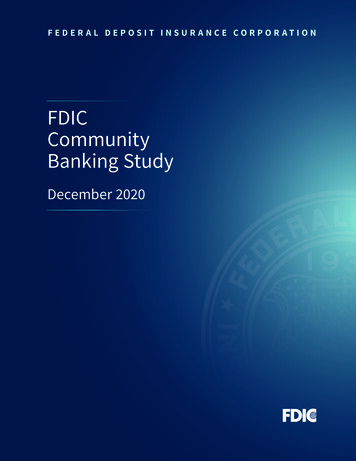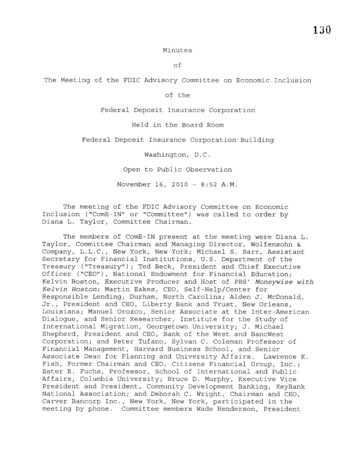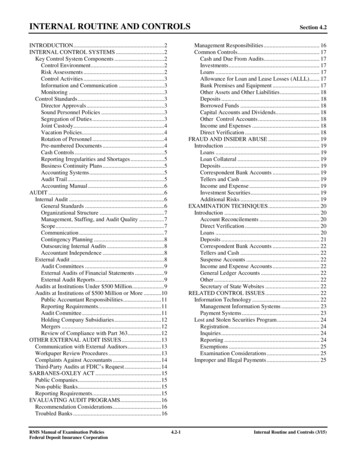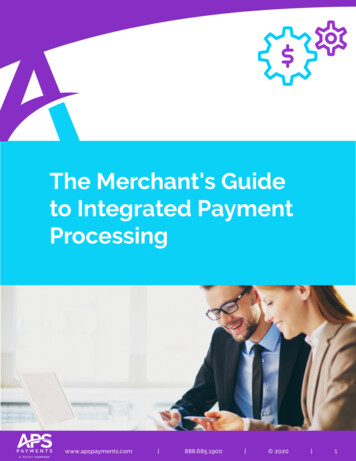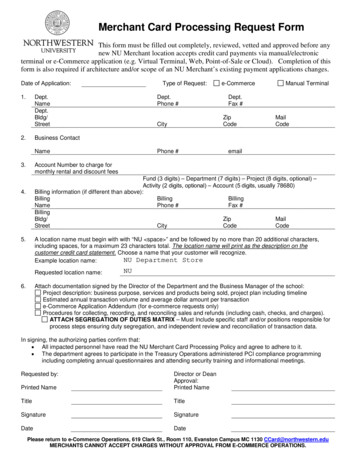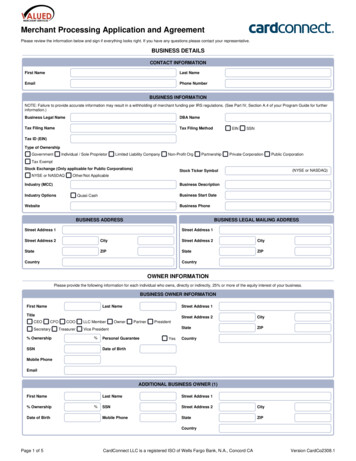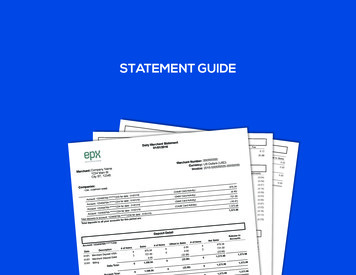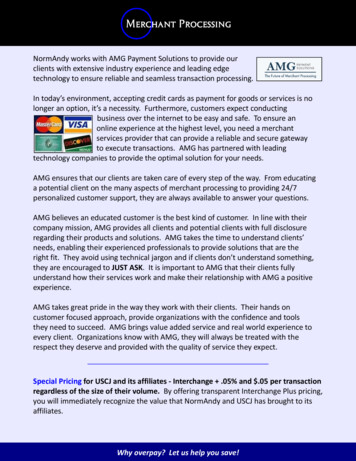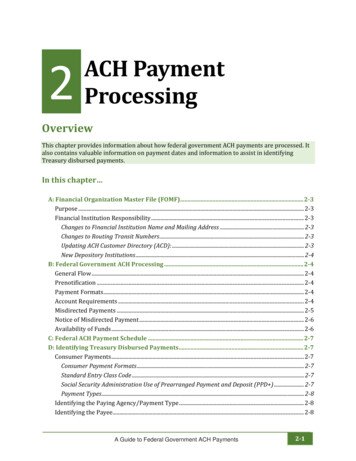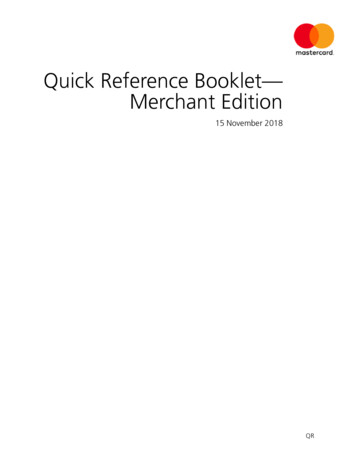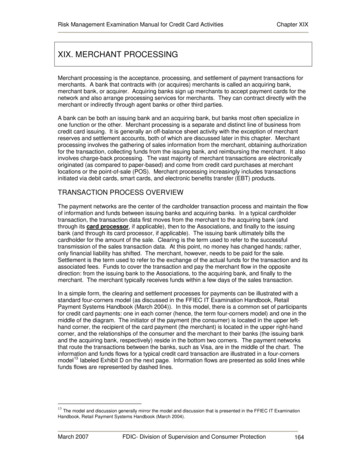
Transcription
Risk Management Examination Manual for Credit Card ActivitiesChapter XIXXIX. MERCHANT PROCESSINGMerchant processing is the acceptance, processing, and settlement of payment transactions formerchants. A bank that contracts with (or acquires) merchants is called an acquiring bank,merchant bank, or acquirer. Acquiring banks sign up merchants to accept payment cards for thenetwork and also arrange processing services for merchants. They can contract directly with themerchant or indirectly through agent banks or other third parties.A bank can be both an issuing bank and an acquiring bank, but banks most often specialize inone function or the other. Merchant processing is a separate and distinct line of business fromcredit card issuing. It is generally an off-balance sheet activity with the exception of merchantreserves and settlement accounts, both of which are discussed later in this chapter. Merchantprocessing involves the gathering of sales information from the merchant, obtaining authorizationfor the transaction, collecting funds from the issuing bank, and reimbursing the merchant. It alsoinvolves charge-back processing. The vast majority of merchant transactions are electronicallyoriginated (as compared to paper-based) and come from credit card purchases at merchantlocations or the point-of-sale (POS). Merchant processing increasingly includes transactionsinitiated via debit cards, smart cards, and electronic benefits transfer (EBT) products.TRANSACTION PROCESS OVERVIEWThe payment networks are the center of the cardholder transaction process and maintain the flowof information and funds between issuing banks and acquiring banks. In a typical cardholdertransaction, the transaction data first moves from the merchant to the acquiring bank (andthrough its card processor, if applicable), then to the Associations, and finally to the issuingbank (and through its card processor, if applicable). The issuing bank ultimately bills thecardholder for the amount of the sale. Clearing is the term used to refer to the successfultransmission of the sales transaction data. At this point, no money has changed hands; rather,only financial liability has shifted. The merchant, however, needs to be paid for the sale.Settlement is the term used to refer to the exchange of the actual funds for the transaction and itsassociated fees. Funds to cover the transaction and pay the merchant flow in the oppositedirection: from the issuing bank to the Associations, to the acquiring bank, and finally to themerchant. The merchant typically receives funds within a few days of the sales transaction.In a simple form, the clearing and settlement processes for payments can be illustrated with astandard four-corners model (as discussed in the FFIEC IT Examination Handbook, RetailPayment Systems Handbook (March 2004)). In this model, there is a common set of participantsfor credit card payments: one in each corner (hence, the term four-corners model) and one in themiddle of the diagram. The initiator of the payment (the consumer) is located in the upper lefthand corner, the recipient of the card payment (the merchant) is located in the upper right-handcorner, and the relationships of the consumer and the merchant to their banks (the issuing bankand the acquiring bank, respectively) reside in the bottom two corners. The payment networksthat route the transactions between the banks, such as Visa, are in the middle of the chart. Theinformation and funds flows for a typical credit card transaction are illustrated in a four-cornersmodel 13 labeled Exhibit D on the next page. Information flows are presented as solid lines whilefunds flows are represented by dashed lines.13The model and discussion generally mirror the model and discussion that is presented in the FFIEC IT ExaminationHandbook, Retail Payment Systems Handbook (March 2004).March 2007FDIC- Division of Supervision and Consumer Protection164
Merchant ProcessingStep 1:Steps 2 and 3:The consumer pays a merchant with a credit card.The merchant then electronically transmits the data through theapplicable Association’s electronic network to the issuing bank forauthorization.If approved, the merchant receives authorization to capture thetransaction, and the cardholder accepts liability, usually by signing thesales slip.The merchant receives payment, net of fees, by submitting the capturedcredit card transactions to its bank (the acquiring bank) in batches or atthe end of the day 14 .The acquiring bank forwards the sales draft data to the applicableAssociation, which in turn forwards the data to the issuing bank.Steps 4, 5, and 6:Steps 7 and 8:Steps 9 and 10:The Association determines each bank’s net debit position. The Association’s settlementfinancial institution coordinates issuing and acquiring settlement positions. Members with netdebit positions (normally the issuing banks) send funds to the Association’s settlement financialinstitution, which transmits owed funds to the receiving bank (generally the acquiring banks).Step 11:The settlement process takes place using a separate payment networksuch as Fedwire.The issuing bank presents the transaction on the cardholder’s nextbilling statement.The cardholder pays the bank, either in full or via monthly payments.Step 12:Step 13:Exhibit D6ConsumerMerchant12512Payment Network(for instance, Visaor MasterCard)1378104931111Issuing BankAcquiring Bank14Acquiring banks generally pay merchants by initiating Automated Clearing House (ACH) credits to deposit accounts atthe merchants’ local banks (possibly an agent bank). If an acquiring bank employs a third-party card processor, the cardprocessor usually prepares the ACH file.March 2007FDIC – Division of Supervision and Consumer Protection165
Risk Management Examination Manual for Credit Card ActivitiesChapter XIXExhibit D is only a simplistic example of the variety of arrangements that can exist. The partiesfor the transaction could be one of thousands of acquirers or issuers or one of millions ofmerchants and consumers. Further, there are many other ways the arrangements can bestructured. For example, in on-us transactions, the acquiring bank and the issuing bank are thesame. Also, the timing of the payment to the merchant (step 8 of Exhibit D) varies. Someacquiring banks pay select merchants prior to receiving funds from the issuing bank, therebyincreasing the acquiring bank’s credit and liquidity exposure. However, payment from theacquiring bank to the merchant often occurs shortly after the acquiring bank receives credit fromthe issuing bank.The presence of third-party organizations coupled with the acquiring bank’s ability to sub-licensethe entire merchant program, or part thereof, and the issuing bank’s ability to sub-license theentire issuing program, or part thereof, to other entities also introduces complexities to thetransaction and fund flows. For example, because the cost of technology infrastructure and thelevel of transaction volume are high for acquiring banks, most small acquiring banks rely on thirdparty card processors to perform the functions. In addition, issuing banks often use cardprocessors to conduct several of their services. In intra-processor transactions, the same thirdparty processes for both the acquiring bank and the issuing bank. Under the by-laws andoperating rules/regulations of the Associations, the issuing banks and acquiring banks areresponsible for the actions of their contracted third-parties, respectively.A merchant submits sales transactions to its acquiring bank by one of two methods. Largemerchants often have computer equipment that transmits transactions directly to the acquiringbank or its card processor. Smaller merchants usually submit transactions to a vendor thatcollects data from several merchants and then transmits transactions to the acquiring banks.RISKS ASSOCIATED WITH MERCHANT PROCESSINGSome bankers do not understand merchant processing and its risks. Attracted to the business bythe potential for increased fee income, they might underestimate the risk and not employpersonnel with sufficient knowledge and expertise. They also might not devote sufficientresources to oversight or perform proper due diligence reviews of prospective third-parties. Manybanks simply do not have the managerial expertise, resources, or infrastructure to safely engagein merchant processing outside their local market or to manage high sales volumes, high-riskmerchants, or high charge-back levels. Many of a bank’s risks may be interdependent withpayment system operators and third parties. For example, the failure of any payment systemparticipant to provide funding for settlement may precipitate liquidity or credit problems for otherparticipants, regardless of whether they are party to payments to or from the failing participant.For banks that engage in merchant programs or that are contemplating engaging in suchprograms, examiners should look for evidence that management understands the activity’s riskswhich include credit, transaction, liquidity, compliance, strategic, and reputation risk. A failure bymanagement to understand the risks and provide proper controls over such risks can be veryproblematic, and even lethal, to the bank. Take, for example, the case of National State Bank,Metropolis, Illinois. Inadequate control of the credit and transaction risks associated with itsmerchant processing activities contributed to a high volume of losses that ultimately depletedcapital, threatened the bank’s liquidity, and led to its closing by the Office of the Comptroller ofthe Currency (OCC) in December 2000. 1515As per press release PR-90-2000.March 2007FDIC- Division of Supervision and Consumer Protection166
Merchant ProcessingCredit RiskA primary risk associated with merchant processing is credit risk. Even though the acquiringbank typically does not advance its own funds, processing credit card transactions is similar toextending credit because the acquiring bank is relying on the creditworthiness of the merchant topay charge-backs. Charge-backs are a common element in the merchant processing businessand are discussed in more detail later in this chapter. They can result from legitimate cardholderchallenges, fraud, or the merchant’s failure to follow established guidelines. Charge-backsbecome a credit exposure to the acquiring bank if the merchant is unable or unwilling to paylegitimate charge-backs. In that case the acquiring bank is obligated to honor the charge-backand pay the issuing bank which could result in significant loss to the acquiring bank. In a sense,the acquiring bank indemnifies a third party (in this case, the issuing bank that in turn indemnifiesthe cardholder) in the event that the merchant cannot or does not cover charge-back. Bankshave been forced to cover large charge-backs when merchants have gone bankrupt orcommitted fraud. Acquiring banks control credit risk by using sound merchant approvalprocesses and closely monitoring merchant activities.Transaction RiskAcquiring banks are faced with the transaction risk associated with service or product deliverybecause they process credit card transactions for their merchants daily. The risk can stem from afailure by the bank or any party participating in the transaction to process a transaction properlyor to provide adequate controls. It can also stem from employee error or misconduct, abreakdown in the computer system, or a natural catastrophe. The acquiring bank needs anadequate number of knowledgeable staff, appropriate technology, comprehensive operatingprocedures, and effective contingency plans to carry out merchant processing efficiently andreliably. A sound internal control environment is also necessary to ensure compliance with thepayment networks’ rules. Formal reconciliation processes are also essential to limiting risk.The high transaction and sales volume normally encountered with merchant processingprograms creates significant transaction and liquidity risks. A failure anywhere in the process canhave implications on the bank. Examples include an issuing bank's inability to fund settlement tothe acquiring bank or a processing center’s failure to transmit sales information to the issuingbank, thus resulting in a delay of or failure of funding to the merchant bank.Liquidity RiskLiquidity risk can be measured by the ability of the acquiring bank to timely transmit funds to themerchants. Acquiring banks often limit this risk by paying merchants after receiving credit fromthe issuing bank. If the acquiring bank pays the merchant prior to receiving credit from theissuing bank, the acquiring bank could sustain a loss if the issuing bank is unable or unwilling topay. Some acquiring banks delay settlement and pay merchants one day after receiving thefunds from the issuing bank. The delay allows the acquiring bank time to perform fraud reviews.For delayed settlement, which most commonly occurs when transactions are identified assuspicious or unusual, management is expected to have established formal procedures.Because merchant deposits can be volatile, risk may also arise if the acquiring bank becomesreliant on the merchant’s deposits as a funding source for other bank activities. Furthermore,substantial charge-backs could potentially strain the bank’s financial condition and/or reputationto such a degree that its creditors may withdraw availability of borrowing lines.Associations guarantee settlement for transactions that pass through interchange. As a result,they may require collateral pledges/security if a bank's ability to fund settlement becomesquestionable. This can create significant liquidity strains and potentially capital difficulties,depending on the size of the collateral requirement and/or the financial condition of the bank.March 2007FDIC – Division of Supervision and Consumer Protection167
Risk Management Examination Manual for Credit Card ActivitiesChapter XIXThe Associations' rules allow them to assess the banks directly through the settlement accountsif the bank is not forthcoming with the collateral.Compliance RiskCompliance risk arises from failure to follow payment networks’ rules and regulations, clearingand settlement rules, suspicious activity reporting requirements, and a myriad of other laws,regulations, and guidance. It can lead to fines, payment of damages, diminished reputation,reduced franchise value, limited business opportunities, reduced expansion potential, and lack ofcontract enforceability. Acquiring banks can limit compliance risk by ensuring a structuredcompliance management program is in place, the internal control environment is sound, and staffis knowledgeable. They can also limit risk by providing staff with access to legal representationto ensure accurate evaluation of items such as new product offerings, legal forms, laws andregulations, and contracts.Strategic RiskStrategic risk arises from adverse business decisions or improper implementation of thosedecisions. A failure by management to consider the bank’s merchant processing activities in thecontext of its overall strategic planning is normally cause for concern. A decision to enter,maintain, or expand the merchant processing business without considering management’sexpertise and the bank’s financial capacity is also normally cause for concern. Examiners shouldalso pay close attention to how the acquiring bank plans to keep pace with technology changesand competitive forces. Examiners should look for evidence that the strategic planning processidentifies the opportunities and risks of the merchant processing business; sets forth a plan formanaging the line of business and controlling its risks; and considers the need for acomprehensive vendor management program. An evaluation of management's merchantprocessing expertise is critical to judging strategic risk. The bank's overall programs for audit andinternal controls, risk management systems, outsourcing of services, and merchant programoversight are key to controlling the strategic risk.Reputation RiskReputation risk arising from negative public opinion can affect a bank’s ability to establish newrelationships or services or to continue servicing existing relationships. This risk can expose thebank to litigation, financial loss, or damage to its public image. The bank’s business decisions formarketing and pricing its merchant processing services can affect its reputation in themarketplace. Reputation risk is also associated with the bank’s ability to fulfill contractualobligations to merchants and third parties. Most notably, the outsourcing of any part of themerchant processing business easily increases reputation risk. Decisions made by the acquiringbank or its third-parties can directly cause loss of merchant relationships, litigation, fines andpenalties as well as charge-back losses. Concerns normally arise when the acquiring bank doesnot maintain strong processes for performing due diligence on prospective merchants and thirdparties or perform ongoing evaluations of existing merchant and third-party relationships.MANAGEMENTExaminers should expect that management fully understand, prior to becoming involved inmerchant processing and continuing thereafter, the risks involved and its own ability to effectivelycontrol those risks. Merchant programs are specialized programs that require managementexpertise, significant operational support, and rigorous risk-management systems. It can be aprofitable line of business but, if not properly controlled, can result in significant risk to the bank.March 2007FDIC- Division of Supervision and Consumer Protection168
Merchant ProcessingExaminers should determine whether qualified management has been appointed to supervisemerchant activities and to implement a risk management function that includes a merchantapproval system and an ongoing merchant review program for monitoring credit quality andguarding against fraud. Bank staff’s knowledge and skill-sets are expected to be commensuratewith the risks being taken. For example, personnel responsible for processing charge-backsshould have the technical knowledge and understanding of charge-back rules, and personnelresponsible for approving merchant applications should have the ability to properly evaluatecreditworthiness and identify high-risk merchants.Examiners assessing risks of merchant programs should direct their attention to situations inwhich management has not put proper risk measurement systems in place to operate, monitor,and control the activity effectively. This includes situations that evidence the absence of regularmanagement reports detailing pertinent information. Key reports generally include new merchantacquisitions, merchant account attrition, merchant portfolio composition, sales volumes, chargeback volumes and aging, fraud, and profitability analyses.Examiner attention should be given to instances in which comprehensive, written merchantprocessing policies and procedures are absent or are not adequate for the size and complexity ofoperations. Necessary components of policies and procedures generally include: Clear lines of authority and responsibility (for example, the level of approval requiredto contract with certain types of merchants).Adequate and knowledgeable staff.Markets, merchant types, and risk levels the bank is and is not willing to accept.Limits on the individual and aggregate volume of merchant activity that correlateswith the bank’s capital structure, management expertise, and ability of operations toaccommodate the volume (e.g., human and systems resources) as well as withmerchants’ risk profiles.Goals for portfolio mix and risk diversification, including limits on the volume of salesprocessed for higher-risk merchants and that take into account the level ofmanagement expertise.Merchant underwriting and approval criteria.Procedures for monitoring merchants, including financial capacity, charge-backs andfraud (regardless
Merchant processing is the acceptance, processing, and settlement of payment transactions for merchants. A bank that contracts with (or acquires) merchants is called an acquiring bank, . billing statement. Step 13: The cardholder pays the bank, either i

